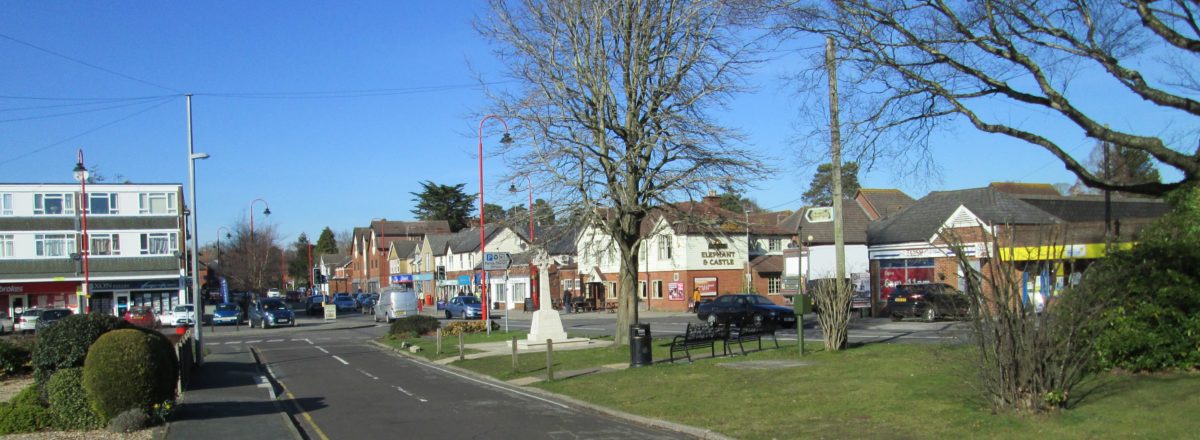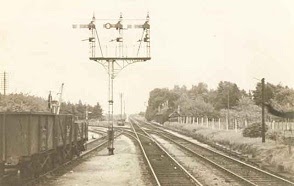
The year 1844 was unremarkable as far as farmers, agricultural labourers and their families living in the northern part of West Parley parish were concerned. They were far removed from the ‘mother’ settlement clustered about the parish church several miles to the south and even the coming of the turnpike roads (in the latter part of the previous century) – which skirted the small community to the south and north, had left these scattered families largely untouched. Life obeyed the age-old rhythm of the farming year – the changing seasons and the vagaries of the weather dictated the daily tasks, with a pace of life little altered from that of their forefathers, stretching back many generations.
But in the bustling market town of Wimborne Minster, and later in Parliament at Westminster, plans were being laid that would bring radical change to this long bypassed corner of Dorset – change that would propel the area into the modern world. In 1845, the Act of Parliament defining the route of the Southampton & Dorchester Railway (S&DR) was signed into law by the young Queen Victoria – and unlike the turnpikes roads, this route would pass east-to-west straight through what is now West Moors.
The first sign of change – perhaps not noticed by most of the inhabitants – would have been the leisurely passage by a surveyor, his assistant and their horses, along what would later become the line of the railway. Their sighting poles would make steady progress across the heathland and farmland – little regarded across the moor, not at all welcome when crossing fields with stock or crops. The tenant farmers would no doubt have been informed by the landowners’ agents that the railway was coming – but even then the potential impact would not have hit home. What happened next certainly would have!
Throughout 1846 & early 1847 scores of rather down-to-earth labourers – hard working, hard living, hard drinking men, no doubt with some choice language in the hearing of anyone closeby, cut a swathe across the heath, tore down centuries-old hedges, crossed small streams and of course traversed the many ancient tracks along the way. First the ballast was laid – with wooden bridges to carry the railway across the Moors river and Mannington brook; then the contractors deposited thousands of sleepers in clusters along the line, ready to be laid on the ballast. These sleepers would bear the two lines of rails, which, when complete, would link the county town of Dorset with Southampton and the existing main line to London.
Where the railway crossed farm tracks, parish roads & turnpikes on the level, then arrangements had to be made – by law – to ensure that those wanting to cross the railway could do so in safety. In essence, the railway was given priority – with gates set across the road / cart tracks in such a way that the railway line was regarded as an ‘estate’ and you needed to have the
gates opened to gain access (and exit) that estate. Whether a crossing was ‘controlled’ was dictated largely by the type of highway. Where a railway crossed private land and access was required an accommodation crossing was all that was needed – a simple set of gates to be opened [away from the railway] & closed by the landowner or his authorised agents (i.e., tenant farmers). Where the railway crossed a private road (e.g access to a farm or a dwelling), then an occupation crossing was installed to allow anyone with legitimate business to cross the railway: these crossings could be manned or unmanned; locally for example, the access to the Uddens estate from the Wimborne Road required a manned crossing – and we had the unusual situation here that to gain access to the grounds, after leaving the Wimborne – Ringwood turnpike (the Leigh Trust) you first entered the estate via the Uddens gate house, then a little way along encountered another set of gates with its own crossing lodge – how much intercourse between the two lodges was there I wonder?
Turnpikes & parish roads had, by law, to be ‘positively’ controlled, if they couldn’t be avoided by a bridge: that means a crossing lodge was built with a resident keeper to operate the gates. Within the area of the modern West Moors parish, the S&DR crossed two local tracks – what is now the B3072, Station Road and the minor trackway through Ameysford. When the railway opened for traffic in 1847, both were of equal status, but over time, that through Ameysford was little used whereas as we know, Station Road even early in the 20th century, was becoming a very busy route.
What was life like for those early crossing keepers? A keeper’s situation was superficially steady and secure; but at three of our ‘local’ crossings, it could be an isolated existence. Even the fourth lodge in West Moors, hardly even a hamlet in 1846 and for many years thereafter, was not blessed with plenty of local people about. A community did grow up around the Station Road lodge (after 1866), but the other crossings were always set apart. One problem was that the keeper was effectively expected to be always on duty – day and night; this would be problematic – for example at West Moors & Dolman’s, trains passed in the middle of the night! The keeper was expected to be available to signal the locomotive & its train across the crossing – even if the crossing wasn’t being used. And of course, the lodges were only a few feet away from the line – sleep would be elusive! Life was somewhat better on the Salisbury line in the early years because there was no Sunday service and the number of train movements over the crossings were limited – four each way to start with. However, if the resident keeper was indisposed and he (usually male in the early days) wasn’t married, life could be tough.
Even where a large family occupied the crossing – and someone was available to go shopping, where were the shops? At Revel’s [later named ‘Revells’] & Ameysford/Dolman’s, there was no handy shopping area nearby. Even at Newman’s and West Moors, until the late 19th century only a single grocery shop was available. Water supply was often from a well – which could dry up in long, hot summers, or become unsanitary – and despite a railway literally passing their front doors, it wasn’t quite the thing to halt the trains to let the keeper or his family down on a whim: though I’ve no doubt that would happen from time-to-time.
Railways were not obliged to provide lodges for the gatemen until 1863, but the S&DR did so from the start of operation of the line. Many crossings (as all of ours were in the early days) were in sparsely populated areas – finding board / lodging for gatekeepers nearby would have been nigh on impossible. Why West Moors (No. 19) and Dolman’s Lane (No. 20) were double-storey, when many of the rest were smaller, often single-storey is a bit of a mystery – though it may be that the company thought that the crossings would have to be manned by younger men with potentially larger families – this was certainly the case (see details later as regards to the families in residence).
One thing to be borne in mind in the early days of all these crossings was that there would have been much resentment over the coming of the railway. Although the large landowners were supportive (and gained financially directly and indirectly), the local tenant farmers would find their fields bisected by the railways – and when they tried to cross the line via the various crossings, they would be subject to delays that they had not experienced before. For example, until bell signals became generally available at lodges in the 1870s (repeaters of the adjacent signal-box communication), the crossing keeper had to exercise a decision whether or not to allow someone to cross. Individuals, those on horses etc., could cross swiftly and the keeper, knowing approximately when the trains were due, could allow passage without undue delay. However a heavily laden farm cart, a herd of cows, flock of sheep etc., would have to wait until the keeper was absolutely sure that no train was due. If he allowed, for example, a heavy cart to cross and it suffered an axle failure half way across, the keeper would have to frantically set red flags at a sufficient distance either side of the crossing to allow time for a train to come to a stop – hand-worked semaphore signals were not provided at many isolated, lightly used crossings until late in the 19th century, and Ameysford/Dolman’s and Revel’s apparently never did have this facility. The following is the instruction to gatemen in the early days of the local railways . . .
“In signalling trains, Gatemen are always to stand outside the gate and on that side of the line nearest to the oncoming train . . . . in giving the ‘All Right’ signal they are to extend their arm at Right Angle in the direction of the train …”
And another source of irritation, at least to labouring peasants – the wages! To a farm-worker being paid just a few shillings a week (9/=, or 45 p in the middle part of the 19th century), the crossing-keeper seemed to have an easy job for a wage (and long-term security) undreamt of by local villagers. The wages for a male crossing keeper when the Southampton to Dorchester railway opened was the princely sum of 23 shillings (~£1.15) per week!
However, the apparent stability of employment was to work against resident keepers as the 20th century dawned: whereas conditions for others working on the railway started to improve with a limit on working hours, better pay and regular days off, it was not to be so for crossing workers! In many of the agreements between staff & companies, crossing keepers were specifically excluded from changes that might benefit them. Not until post the Second World War did regular time off become generally rostered for crossing keepers – with relief keepers standing in. However, by the 1950s, most lodge keepers – and there were still thousands across the country – had effectively been ‘forgotten’ by unions and management alike. And one final insult – women increasingly ‘manned’ the more remote crossings, either taking over from deceased husbands or letting the husband work elsewhere on the railway. Women were paid significantly less than men performing these functions – and this anomaly was never properly addressed.
The Local Crossing Lodges . . .
Within the immediate area covered by the series of articles on this web site, there were four railway crossings that required the building of housing to accommodate resident crossing keepers.
In addition, apparently, a crossing was proposed close to Dolman’s Lane, a little way back towards West Moors, where the Dolman’s Farm track crossed the railway – no record of a manned (i.e., lodge-controlled) crossing exists, but of course there was a user-operated crossing to access the farm.
The locations are shown on the map: below.
On the old main line, the Southampton & Dorchester Railway (S&DR) built two lodges – always regarded as ‘twins’ due to the strong similarity between them. They are regarded as ‘special’ as they are a two-storey variant of the standard single-storey lodge built elsewhere: it is not known why double-storey was chosen – they aren’t the only two-storey lodges – Uddens was another, though of a completely different design. The lodges were West Moors [S&DR/L&SWR No. 19] ‘Station Road’ crossing (though not known as that of course until 1867) and the Dolman’s or Ameysford crossing [S&DR/L&SWR No. 20]. These were built and operational for the opening of the line in 1847. It was necessary to build these lodges (as at many places elsewhere along the line, e.g. Woolsbridge) as local accommodation was not available and it would have been difficult to maintain watch on the gates otherwise. Numbering originated with the line’s opening.
There were a further two lodges built by the Salisbury & Dorset Junction Railway (S&DJcR) on its line that left West Moors and struck out north towards Verwood, Fordingbridge & Salisbury. These were Newman’s Lane [S&DJcR No. 7] and Revel’s crossings [S&DJcR No. 6]. Although assumed that these were built for the opening of the line in 1866, I can’t find any reference to them in the 1871 census return (but can ten years later), and my assessment is that these were built in the early 1870s – more later.
Lodges were built generally on a sufficient area of land to support a vegetable garden and to dispose of human waste, which in turn had to be far enough away from the often provided well. From maps of the 19th century, it appears that all four of our ‘local’ lodges had similar land area and a well available. Throughout their operational life, extensions were added – though generally of the ‘lean-to’ variety and often not in keeping with the basic/original design. This certainly happened at West Moors (side and rear) and Ameysford (rear); Revel’s / Revells appears to have been largely untouched (apart from a substantially constructed “lean-to” on the Verwood side) until after the railway closed (major extension in the late 1980s) and Newman’s Lane was also not altered until well after the railway was shut down in 1964; it was however extensively changed in the post-railway era.
Station Road crossing (or Southampton & Dorchester Railway No. 19, and probably known simply as “Crossing number 19” or “No. 19 Gates”):- built in time for the line opening in 1847 (in date range late 1845- early 1847) and it would have had to be ‘operational’ before the formal first-traffic given the passage of local users. A resident crossing keeper was in charge until the Junction signal box took over control of the crossing in 1904 – this being the year the box was re-located to the Station Road end of the upside platform: because of the heavy railway traffic by the end of the 19th century, other members of staff would have attended the crossing – relatively easy to do with the station nearby. Large double-gates were installed, held against the road early, against the railway later. Eventually these were worked / interlocked from the signal box but for much of the 19th century, they were hand-worked. And as noted elsewhere, the gates were closed to road traffic – which wasn’t too onerous for local people until the growth of road traffic in the early 20th century, but would have been a real inconvenience for farm traffic. After 1904, the lodge was available for railway staff but not necessarily to control the crossing. The lodge remained in railway ownership for staff. The lodge is still extant (as of 2014) though somewhat modified from the original pattern.
Ameysford crossing (or Southampton & Dorchester Railway No. 20, Dolman’s Lane or “No. 20 Gates” or “Crossing number 20”):- built in time for line’s opening in 1847 (in date range late 1845- early 1847) and, as for West Moors, it would have been ‘manned’ well before the first ‘operational’ traffic in 1847. There was a resident keeper until 1959, after which the crossing was reduced to ‘occupation’ status as an attempt to save money. Trackway traffic would have always been light & principally concerned with local farming activity. There was a large single gate across the road/track (always more of a ‘track’ hereabouts). No signals, though some maps show signal posts close-by which are taken to be Uddens & West Moors distant signals. There was a telephone which helped the keeper stay in touch, especially with ‘out-of-timetabled’ movements. Incidentally, in the original plan deposited in Parliament, yet another crossing with a lodge was authorised for the Dolman’s Farm access – though in the end, it was only ever an occupation crossing. Given that the ‘Lane’ (with lodge) crossing and the ‘Farm’ (without lodge) crossing were not that far apart, the resident keeper at the Lodge could keep an eye on the irregularly used crossing accessing the farm. Until the early 20th century, the family living here must have felt very isolated – with West Moors being the nearest place for purchase of groceries; however, very quickly after the turn of the century Ferndown development gathered pace and this must have been a boon to the residents of the lodge. The lodge building was demolished sometime in the 1970s and the entire site has been greatly developed.
Newman’s Lane crossing (or Salisbury & Dorset Junction Railway No. 7):- keepers were resident from at least the early 1870s, though there was probably an unattended crossing beforehand. Early in the 20th century (opened October 1913) a small crossing-keepers hut was built on the opposite side of the road to the lodge, to better attend to the ground frame and gates. Newman’s Lane (as part of the road from Three Legged Cross to West Moors) had fairly light traffic until the 1900s, after which with an increase in automobile use, working the gate (large, single, with pedestrian side gates) would have become very much a full-time job; indeed, from at least 1913 it had its own signals to control railway traffic – something that Revel’s further up the line did not: the ‘distant’ signal to the north was fairly close to Revel’s Crossing.
It must have been a particularly busy crossing during the period of the Second World War when the fuel depot was being developed, from 1943, as large convoys of road fuel tankers lumbered across the railway on their way to distribution points across Dorset & SW Hampshire.
The lodge is still extant (as of 2014) though greatly enlarged / modified; from the external appearance of the house, I suggest it has had at least two major ‘makeovers’ in its post-railway life.
Revel’s crossing (or Salisbury & Dorset Junction Railway No. 6, or, in later years, Revells / Haddons Lane):- this crossing was needed once local farms started using the crossing more regularly from the 1870s. Revel’s is on a little-used track that passes through Sturt’s Farm and there were alternatives available. However, two local yeoman families, the Revels (hence the name – slightly altered in later years) and Stainers, leased land from the landowner (Fryer) in 1869, having probably ‘squatted’ on the land previously, and developed busy agricultural-based operations which required controlled passage across the railway. Individuals crossing a line were no problem – but a herd of cows or flock of sheep or a few recalcitrant pigs needed time to safely get across the line – so it was important to have someone who knew when the next train was due! This was achieved, as elsewhere, by a signalbox repeater bell housed in the kitchen. There were no signals controlling the crossing – so if there was an obstruction of the railway, the keeper would have had to rapidly deploy flags (and later detonators) either side of the crossing to stop a train. The lodge is still extant (as of 2014), and apart from an extension on the ‘Verwood’ side of the lodge, it very much as originally built.
This map (below) is based on the late 1940s / early 1950s version of the Ordnance Survey map, made available via the ‘Vision of Britain’ web site.
It shows the locations of the four crossings noted in this page. At this date, ‘West Moors’ was not operational as a crossing lodge, its functions having been taken over when the signal box moved to the up platform in 1904. Otherwise all the others had crossing keepers resident and ‘active’.
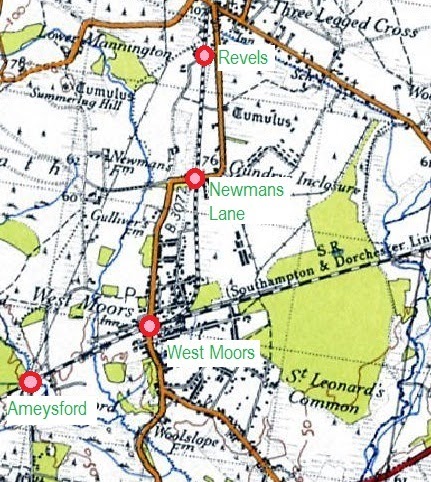
Some images of the various crossings (where available) are shown below.
This image (below) shows the West Moors (No. 19) crossing lodge in the early decades of the 20th century – probably post Great War. At this time it was essentially ‘as built’ but with sloping roof extensions both to the side (left-hand in this shot) and to the rear. Note / compare the position of the chimney stack between this view and that in the image underneath. Also seen in this photograph is the gate to the downside loading dock – and it is tempting to speculate that, as the station didn’t open until 1867, the crossing-keeper had the ‘oversight’ of the dock as part of his duties. I’ve talked more about this elsewhere. The railway (double-track) passes from left to right in front (as viewed here) of the lodge, with the station, its footbridge & the signal box on the right.
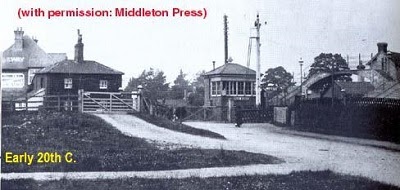
And here (below), with the railway long gone, the same building in 2009. A much ‘cleaner’ profile, with the rear sloping extension, which persisted until at least the 1980s, replaced by a more substantial extension more in keeping with the original building. The chimney has been moved – a single stack now – replacing the original lodge door on the ‘street’ side of the building; the original chimney had gone by the early 1970s, but the replacement stack wasn’t put in place until much later. The railway would have passed to the left of the house as we look at it – very close indeed with the up-line trains passing through the space occupied by the substantial hedge! All other traces of the railway hereabouts have long since disappeared.
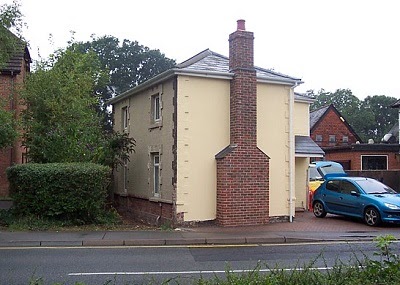
This (below) is Revel’s crossing lodge (S&DJc.Rly No. 6), taken in summer 2013. The single-track railway would have passed to the immediate right of the fencing – behind the photographer is the Verwood & Salisbury direction, forward to Newman’s Lane and West Moors Junction.
You can see the late 1980s extension in this view, but otherwise the lodge is externally much as built in the 19th century. The well, apparently condemned in 1958, was roughly on the left-hand edge of the image: water after this date, until ‘mains water’ arrived in 1961, was brought down from Verwood in three churns – on the mid-afternoon train leaving Salisbury, on Mondays, Wednesdays & Fridays.
The building just about visible on the left is a shed made of old railway sleepers. In fact from its age, it’s just possible it dates from very early in the life of the lodge.
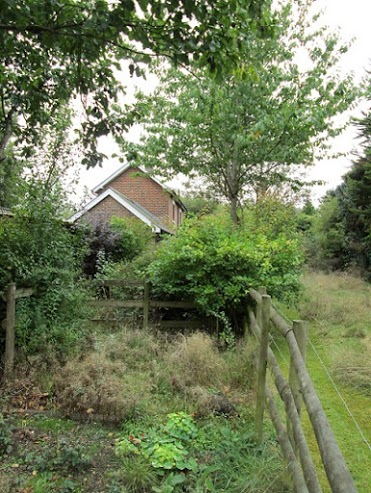
Another view of the same lodge but from the other side – i.e., the view for crew / passengers coming up the line from West Moors and heading towards Verwood, Fordingbridge and Salisbury. The door seen would have been the main door, allowing the keeper to gain quick access to the crossing – which is roughly where the photographer is standing.
The ‘No. 6‘ plate, that defined the lodge for passing train-crew, was on the railway-facing side of the lodge, level with the ground-floor window lintels; this area is obscured in this image.
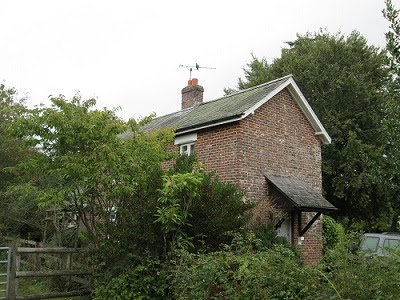
And this (below) is Newman’s Lane in its modern incarnation. I have yet to stumble across a photograph for this lodge from its working days. You can just about make out the shape of the original lodge by tracing the change in character of the brickwork on the wall facing the road – and comparing with Revel’s (above) shows that in this respect anyway, they were very similar. The railway crossed the road and passed along where the modern-day driveway is. On the opposite (West Moors) side of the road was a tarred wooden cabin for use by the relief keeper.
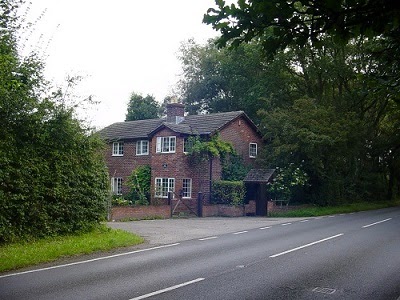
The keepers & their families . . .
I wasn’t going to include anything about the families living in the Lodges as my sources are primarily census returns (which are only available to 1911 currently) and they can lead you astray quite easily! However, as these days many people will be researching their family history via the internet – the notes below may be of some interest – but always bear in mind the aforementioned limitations.
At ‘Number 20’ Lodge (also known as Dolman’s Lane, Ameysford etc.), in 1851 the resident ‘railway gate man’ was James Prince. Given that this is only four years after the opening of the railway, it seems reasonable to assume that he and his wife, Frances, who was ten years younger, were in post from the beginning: what he had been doing prior to this is open to speculation. They were both born in Boldre, Hampshire which is not far from Lymington – which would not at the time have any railway association. They do not have any children living with them by the census return; they may have been childless, or any children may have left home. However, living with them as a visitor on this spring night in 1851 was Elizabeth Prince who is listed as a ‘Ship carpenters wife’ and she has a daughter, also called Elizabeth, just one month old – and listed as being born in the parish, probably at the Lodge. It is reasonable to assume that Mrs. Elizabeth Prince was the sister-in-law of James, and that her husband was away at sea. Ten years later though, and James and Frances (though entered as Francis) were on their own – and James is entered as “SWR Gatekeeper”. On to 1871, and James and Frances are still there, he is listed as 69 (doesn’t quite match up with earlier returns – a common problem), his wife 59, and still giving valiant service to the railway – which by this time would be a very busy double-track main line, with trains passing the crossing at all hours of the day and night. It all came to an end in 1873, as there is an entry for the burial of James, aged 71, at Hampreston church on the 18th September. Assuming his railway service began circa 1846 and he was able to work until shortly before his death, that is 27 years working for the S&DR/L&SWR. Tentatively, from viewing the census return for 1881, it looks as if his wife, Frances, remained in the Lodge as gate keeper for a few years, but by the 1891 census, the resident keeper was Frederick Britton, with his wife Sophia and their four children. The youngest daughter, Martha, was born in 1885 in ‘Fern Down’, so I suggest that Frederick and his family took over the lodge around that year.
Back up the line at Number 19 Lodge (later the Station Road crossing), and we’re in the ‘heart’ of the modern-day village, but in 1847 of course, there was very little – not even a station! It must have been a lonely existence at first for Thomas Bartlett [ listed as “Railway Gate Keeper” ] and his (then) small family: his wife, Elizabeth, his son William John and daughter – not long born in 1851, Elizabeth Ann. She was born in the Lodge, but the son entered this world elsewhere. As was quite usual at the time, I suspect that Elizabeth (mother) went back to her family home for the birth – the railway lodge in 1849, the year of William’s birth, would have seemed very isolated. Moving ten years on, and the fact that the railway was now a double-track, busy main line has not prevented Mr. and Mrs. Bartlett from increasing their family considerably. The 1861 census lists eight children – eldest the aforementioned William John (12 yo), youngest Eliza (1 yo): Apart from this latter, all are listed as ‘scholars’ – and it must have been a struggle to bring up this brood in what was (and still is) a very small house. To confirm the status of the crossing – in the same 1861 census, there is a family living nearby with a name that will resonate throughout West Moors history: Wilcox. John Wilcox is also listed as “Railway Gateman” with his wife, Elizabeth (yet another), and five children – all of them wage-earners, despite the youngest, John, being only 12 years old. He is listed as an agricultural labourer, as are his brothers: George (15 yo), Edgar (21 yo) and David (25 yo) – all unmarried at this time. The remaining sibling, Jane, is a dressmaker, aged 23. What happens subsequently I can’t relate, but by the 1871 census, there is no sign of the Bartletts, and John and Elizabeth Wilcox, with their youngest son John have now taken over the Lodge (known now as “4 Station Road / Railway Gatehouse”) – with father and son both listed as railway gatemen. This confirms the requirement for more than one nominated attendee at this busy crossing – and might backup the supposition elsewhere that as well as operating the gates, other duties in connection with the down-side goods siding were performed. In 1878, John Wilcox senior died, leaving his wife as the sole occupant of the Gate House – she is now 75 years old and is listed as ‘Annuitant’, which suggests that she had no duties on the gates. Elsewhere in the nearby railway cottages (close to the junction & then signal box), John Tiller is listed as ‘Gateman/Pointsman’, with wife and unmarried son – the latter a porter. I suspect that gates by this time were operated as required by whatever staff member was available.
Now we’re off to the Salisbury & Dorset Junction Railway – and to Newman’s Lane, the first manned crossing for trains leaving West Moors. This would become a very busy crossing by the time of its closure, with a crossing-keeper’s hut from 1913, but when the line opened in 1866, I’m not totally convinced there was a manned crossing there – as discussed above. The first census return with a mention of a ‘Gate House’ is 1881, when Hannah Jennings is listed as ‘Head’, aged 43 and defined as ‘Gatemans Wife’, but she is undoubtedly the full-time keeper at this crossing. It appears that Mr. Jennings was in East Anglia, also as a crossing keeper. Living with her was Tom, their 11 year-old son and Eliza Jennings, ‘Aunt’, unmarried – aged 69 and ‘Annuitant’. In 1891 & 1901, Hannah is still there, but her husband has died – and she is now listed as the Railway Gate Keeper – in 1901 she would have been aged 63 – gamely carrying on her lonely occupation. Hannah’s story would be replicated across the British railway network, unsung heroines of the railway network.
[After notes for Newmans Lane – written in 2019: in 1914 (and perhaps 1911 – lack of information) the name of the keeper at Newmans Lane was Walter Jacobs, with his wife Mary and five children. At some point around the 1940s/1950s, the keeper’s name at Newmans Lodge was a Mr. Horne, related to Mr. Adams, the husband of the keeper up the line at Revels (q.v.)
I haven’t been able to fill in any of the other gaps as yet.]
And heading up to Verwood, the next manned crossing was Revel’s – named after the agricultural labourer-turned-farmer who lived adjacent to the crossing and who, with another farmer, Stainer, justified the provision of an attended crossing. However, given that the line opened in 1866, you’d expect a ‘lodge’ or similar to show up in the 1871 census, but there is no sign. There is an entry in 1881: “Gate House”, with James Davis, aged 59 as “Gateman on Railway” with his wife, Mary, aged 63. However, wind back to 1871 and James and Mary are in the area: in the Cranborne census (which parish included Verwood & Three Cross), James is listed as a “Railway Servent” (sic), born at Woolsbridge just a little way away, aged 45 with his wife Mary aged 49. They have an unmarried son with them, Albert (17 yo). And the Davis ‘wider’ family has strong connections with the new railway, because adjacent (in the census and probably physically) is living Thomas (38 yo) & Elizabeth (31 yo) Davis, he also a “Railway Servent” (sic). Given the ages of the two Davis male householders, perhaps they were brothers. Both families are listed as living on the Horton Road, which suggests that they were close to where the railway crossed the road (via a bridge), and it’s tempting to suggest that one or other of the Davis family had the care of the crossing before a lodge was actually built. Of passing interest, the Davis name appears frequently in the census covering Woolsbridge / Three Cross. By the time of the 1891 census, James’ wife has died – he is listed as a Widower (aged 67), “Railway Gatekeeper” with his grand-daughter, Alice (aged 18) living with him as ‘housekeeper’. It must have been a lonely life.
To a certain extent, I can carry on the story of occupants of Revels / Revells (or even Revelles or West Parley Crossing in some texts) by using the available census returns (1911 last available), the 1914 listing of people with jobs / professions in the West Parley parish, the account by Deryck Wiseman in his book West Moors for Ferndown, and from notes provided by Aubrey Adams, the son of the last crossing-keeper to work the gates – to whom I am very grateful for allowing me to use so much of his family history. Using the 1901 census, it is not clear who is in residence at this crossing as they didn’t list the location by name, but by deduction I suspect it is one James Masterman. How long he had tenure is not clear, but by 1911, the lodge is occupied by Edward Guy and his wife Ada – but no other family listed at that time; Edward is 58 and comes from Sussex, so he is definitely out of his ‘patch’ – not even on the same railway! He was there in 1914 (with some additional family listed now – two children), but in that year he was replaced by Charles Waterman & his family (four children). Mr. Waterman’s son, Walter, was to join the railway as a porter at West Moors (according to Wiseman), & Aubrey says that his brother, Norman Waterman, who lived at Three Cross was a relief signalman covering a large area.
In 1942 [July], Charles Waterman was replaced by Mrs. Ina Adams (though she initially took up residency and her duties in her unmarried state as Ina Miller; she married Lionel Adams shortly after). Mrs. Adams’ service with the railway ended after the last revenue-earning train had passed (Saturday evening 2nd May, 1964) and the gates were then locked across the railway (except for the passage of track-lifting formations) allowing un-hindered passage down Haddons Drive (as it had become known) for the first time in around 90 years. However, the line (& associated equipment) wasn’t ‘lifted’ until spring / early summer of 1965 – by which time Mrs. Adams had found a job at the local army fuel depot (Officers’ Mess): coming after a life spent working often on her own – and to most irregular hours with little time off, this must have been a welcome change! Her family were offered the chance to buy the lodge, but the asking price of £600= (very approximately £15000 – £20000 at today’s prices) was too high for them, and it was sold elsewhere – however Mrs. Adams had security of tenure for the remainder of her life.
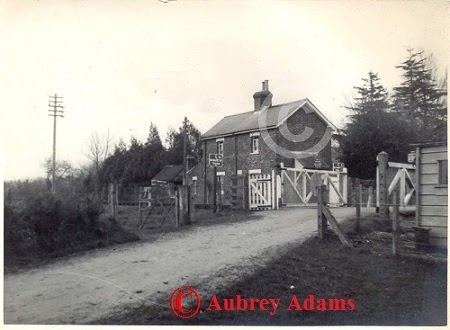
Mrs. Adams’ husband had non-railway employment elsewhere and he never operated the gates. I did think that neither husband or wife had a previous connection to the railway – which historically would have been somewhat unusual; I have since learned that Mr. Adams was related to Mr. Horne, the keeper at Newmans Lane at the time – it was of course wartime so that may have been an additional factor. She remained in the lodge until her death in 1992. Throughout the ‘operational’ period of Mrs. Adam’s tenure (1942 – 1964), facilities at the crossing house were very limited – see later.
Courtesy of her son, we have an image [see above] of the crossing lodge in its late ‘working’ phase: he provided some record of life in the lodge in the 1950s and 1960s, and in essence there had been little progress for the occupants since the earliest days of this crossing. Note that the No.6 identifying plate was on the line-facing side of the lodge, on a level with the bottom window lintels, and between the two main windows facing the railway. In his time, the maximum number of people who would be living in the house (two up, two down plus the kitchen ‘add-on’: see below) would be six, but using only two bedrooms!
There was no electricity provided until 1960; before that date, oil lamps were generally used for lighting, though downstairs, where gas was laid on, there were three gas brackets fitted to the ceiling and gas was also used for the cooker. However, the large copper – mounted on its large brick plinth (for boiling water on wash day) was coal fired. Piped water was also a late arrival – 1961, provided by a ‘T’-off the feed to the nearby farm. There was a well in the garden, but it was condemned in 1958 – and in any case the water wasn’t really suitable for drinking by this stage in the property’s life. In Aubrey Adams’ time (Fifties, early Sixties), until arrangements could be made to tap into the main supply to an adjacent farm, water had to be brought either down the line from Verwood (in churns) on the early / mid-afternoon working ex. Salisbury three times per week: Mondays, Wednesdays & Fridays. However, there is a record that water was being transferred up the line – probably from West Moors, as they had had mains water in the village since at least 1906 – and on either morning or early afternoon trains. The train, usually a passenger working, had to come to a stop (sometimes they forgot!) straddling the crossing and the Guard had to manoeuvre the somewhat weighty churns so that Mrs. Adams could take them down to the ground – not exactly an easy task remembering the difference in height between the floor of a carriage and the track! And apparently because ‘things’ appeared (to occupants of the carriages) to be happening at this ‘stop’, the Guard had to be alert to prevent passengers opening the doors and trying to get out; it would have been a long & painful drop!
The newspaper article (below) was published in August 1960. It concerns the lack of a piped water supply to the railway crossing lodge on the Salisbury & Dorset Junction Railway at Revels Crossing, near Three Cross [ or Three Legged Cross ], north of West Moors, Dorset.
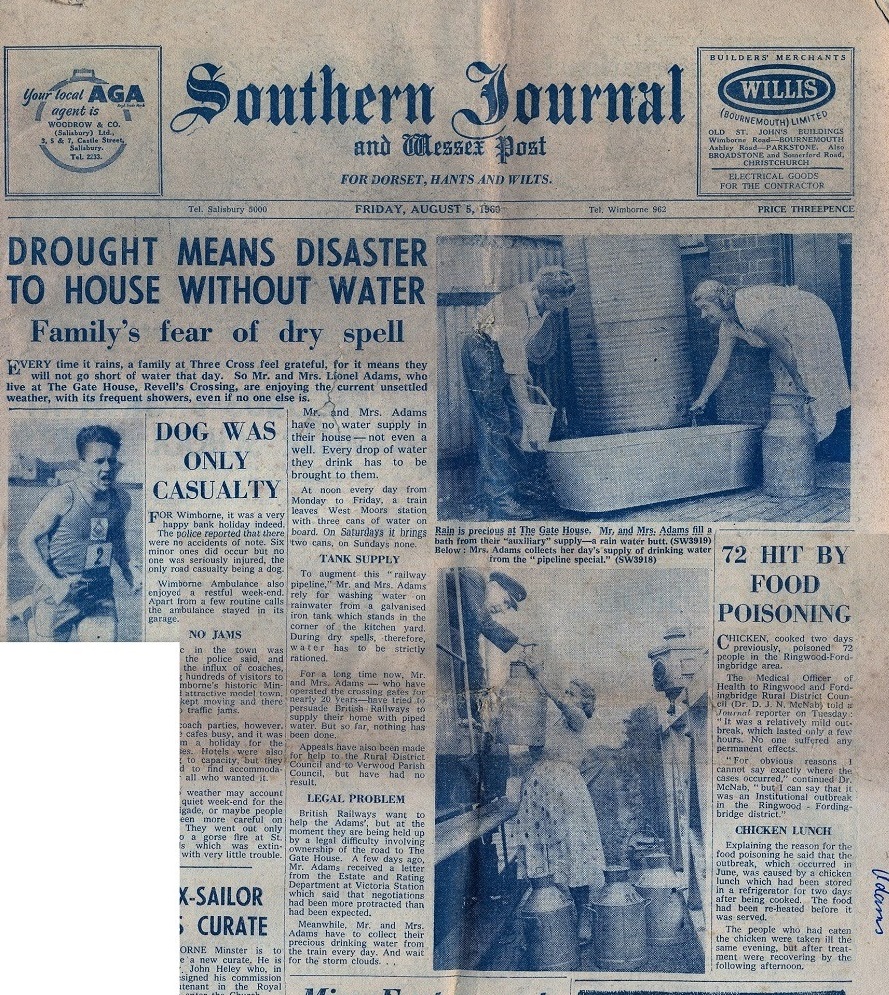
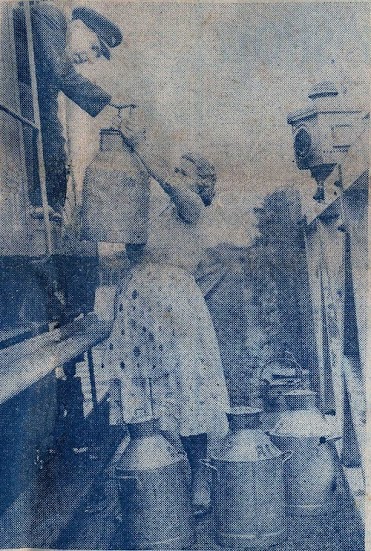
Piped water was provided – in the following year: by taking a ‘T’ feed off an already existing mains water supply to the adjacent farm.
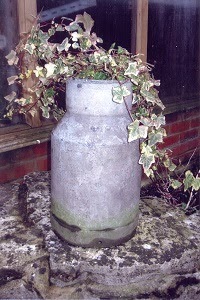
The image, courtesty of Aubrey Adams, is of one of the water churns that would have been used – some were bigger – and of course it has long ceased to be used for its intended purpose!
The brick-built, slate-roofed kitchen on the Verwood end of the Lodge contained the aforementioned copper, cooker and a pantry. The latter ran the whole length of the back wall of this kitchen on the side furthest from the railway line. This single-storey kitchen was replaced many years after line-closure in 1991, though unfortunately Ina Adams would not really benefit. A collecting (or ‘septic’) tank to collect kitchen ‘grey’ water was on the opposite side of the track from the lodge, close to the gates, fed by pipe, but toilets were chemical affairs in a little hut built of sleepers at the far end of the larger outhouse, also built of sleepers: as of 2013/2014, this latter outhouse is still extant. Apparently the relief keeper had his own ‘facilities’.
The ‘main’ back garden, which included the shed, well & toilet, extended a good way along the line (in the direction of Verwood): there was another extensive strip of land, used as a garden, with plenty of room for chickens & geese and for growing plum trees, on the other side of the crossing – that is on the same side of the lodge towards Newmans Lane. According to Aubrey, it extended around a third of a way towards the Newmans distant signal and as such was larger than the ‘attached’ back garden. It appears that this was ‘railway-owned land’. The combined gardens were large – and Mrs. Adams was very proud of them.
The door nearest the crossing (on the end of the Lodge) was not in general use – though presumably the original designer intended that it should be the main access point when the keeper attended the crossing; in reality it was much more convenient to use the kitchen door. In the kitchen there was a telegraph repeater bell – fed from the lineside telegraph lines on the opposite side of the track, to a telegraph pole immediately outside the extension (see photograph above): there was the facility to switch the bell signals to the lineside cabin when the relief keeper was in residence in his little hut. There was no provision for ‘answering’ these signals – they were simply passive repeaters (see later).
Note that the provision of a relief keeper’s hut would not have been a feature of life throughout the life of the lodge: it was never intended that anyone other than the permanent / resident lodge keeper should be responsible for the crossing; only with restricted working hours from the early decades of the 20th century did the concept of time off (limited) with relief keepers come into play. In Aubrey’s time, the relief was Les Woon, who lived at Fordingbridge (up the line, in Hampshire): he would arrive on his moped – responsible, in rotation, for other such lightly-used crossings along the line – see later. There is also a record of ‘shopping relief’ being provided from 1944 by a detached porter from Ringwood: this was for four hours, once per week – hardly generous! Mrs. Adams had just one week’s holiday per year, plus the short breaks outlined below.
Occupants of the Lodge would quickly become accustomed to the noise and vibration as a train ran by – this was apparently a common experience for such line-side crossing-houses. Aubrey, who grew up in the lodge, says that so used was he to the passage of trains that often the only time he was aware that a locomotive had passed by was the tell-tale smell of sulphur!
Broadly, the ‘running’ day along the line would be from around 4 to 4.30 am to circa 10 pm. Except in wartime, I believe there was no ‘dead-of-night’ traffic on this line. The crossing-keeper of course had to be available at any time of day or night – for example to allow the vet to make an emergency visit to one of the farms.
The normal position of the gates was across the lane that gave access to the two farms – users needing to have these opened (including farmers wanting to bring stock across the line – at least twice per day for ‘milkers’ from the farm closest to the crossing), had to alert the keeper by calling at the lodge (or notifying the relief keeper in his cabin): one bane of keepers was motorists who would draw up to the gate and lean on their horn! Pedestrians though could use the side / wicket gates; there were the usual cast-iron warning signs either side of the crossing (ex-LSWR, modified by the painting-over of the ‘L’ and ‘W’).
The section of the line passing Revel’s / Revels / Revells (it was sometimes called West Parley Crossing / Xing on some BR (SR) documents!) was straight – and assuming visibility was good, trains could be seen approaching in good time from either direction. In addition, as this line was only ever ‘powered’ by steam-traction, the distinctive exhaust beat of a locomotive would also warn of approach – this was more evident for engines coming up from West Moors, as they would be climbing (gently) with regulator open; for locomotives coming down from Verwood, the regulator may have been shut off (or closed-down considerably) as the line falls gently past the crossing – and drivers would be preparing to slow on the approach to West Moors Junction.
Gatekeepers at such crossings as these weren’t expected to be standing-by as trains passed (as would have been the case in very early days), but they were expected to make sure that the crossing was clear, and the gates hadn’t been interfered with overnight – the gates were locked in position, whether open or shut: Mrs. Adams had a (spare?) key to the gates – and Aubrey now has this as a reminder of his railway days.
The crossing keeper would know what the various bell signals would mean: Revels/Revells was on a block section that could be varied in length. In ‘normal’ operation, the relevant blocks were: Fordingbridge=Verwood and Verwood=West Moors. (Daggons Road was between Fordingbridge and Verwood but only had a ground frame to manage the sidings there). The bell ‘note’ was slightly different depending on which box was calling. With the distances involved, the keeper could assume that a train leaving Verwood would be with her in around 4 minutes (depending upon type), and one leaving West Moors in about 3 minutes. After the ‘alert’ signal (1 beat – repeated back – 1 beat [1 R 1]), the departure box would ‘offer’ the train to the box in advance [and the appropriate token procedure carried out] using a series of unique beats, which would be repeated back to acknowledge-authorise-accept depending on the type of train. Once accepted the box in rear would confirm that the formation had actually entered the section (SR branch code=4 beats, repeated back 4, [4 R 4]), and at this point, the keeper would know that a train was hurtling down the line for the crossing: standing regulations would mean that no opening of the gates was allowed at this point – a source of much frustration to some of the users of the crossing!
When traffic was light – Sundays being the obvious case, along with early and late – Verwood could be ‘switched-out’ of circuit creating a lengthy Fordingbridge=West Moors block. This didn’t make much of a difference for trains leaving West Moors – it still took only 3 or 4 minutes to come up the slight gradient; however, for down trains (i.e. those leaving Fordingbridge), the “4 R 4” sequence meant that Revel’s would have between 18 and 25 minutes to wait, depending upon whether the train stopped at Daggons Road & Verwood, whether it was a slow freight, a light engine etc. The keeper had discretion to allow traffic to go over the tracks but extra care was needed with stock and farm carts – if a cow was wayward or the cart broke down, there was no easy way to stop a train if the crossing was ‘fouled’. ( Newman’s Lane of course were better provided for – they had a set of signals! )
All routine ‘first-line’ maintenance of the crossing was the keeper’s responsibility, including clearing snow, greasing the gates, filling the lamps etc. External painting, when done, was achieved by a periodic visit from a local contractor, but the keeper was responsible for decorating inside the lodge.
The West Moors station master could appear at any time on a snap check – West Moors was responsible for this and several other local crossings – and the District Inspector (in Aubrey’s time, one “Inspector Rook” [*]) could also call at any time unannounced to inspect the equipment and make sure all was well.
{ [*] In fact this is Vic Rooke (or P.V.W. Rooke / Rook – some confusion over whether there is a trailing ‘e’) and I am indebted to the publication “Steam Days In Dorset”, author Michael Webb for much more on this man: he was the inspector of signalling for a wide area – based at Branksome. He had taken over from Inspector Parfitt in 1943 (according to Webb) – moving from Salisbury. No doubt he was of the ‘old’ school – probably starting his service with the L&SWR, perhaps as a porter, but quickly moving up to signalman – as his reputation was that of someone who knew the rules and regulations backwards – and was highly respected by men and managers alike. His task was to check, instruct & validate across the local network on all matters to do with safety of the running lines controlled by the signalboxes and crossing-keepers. He was the archetypal ‘legend in his lifetime’ character and I estimate that he would have retired roughly when the local lines were being closed-down wholesale – thus probably being Mrs. Adams’ Inspector for all of her railway life. }
The Newman’s Lane ‘distant’ signal was not far from the lodge (in the West Moors direction) and periodically the keeper from N/L had to come up to clean/refill the lamps etc. Sleepers in later days were concrete towards West Moors from this signal, and old-style wood (oak) otherwise. This was beneficial to the occupants of the lodge as the ‘noise’ was notably ‘softer’ when trains passed over wood sleepers than over the concrete ones. I’m told that there was little if any contact between the occupants of Newmans and Revells – which considering how close they were (5/8 of a mile, 1 km) is interesting (but there is a familial link – see above – so I suspect some sort of ‘personal’ contact was maintained). Wages were collected weekly – Thursday afternoons in Aubrey’s time – from the Junction station at West Moors. The Station Master was responsible for several crossings in the area: at the time of collecting the wages, details of special workings would be notified which supplemented the working time-tables (WTT) for the line, issued two or three times per year.
There was no telephone (public or ‘closed’) to the lodge – in emergency, Mrs. Adams had to go to the adjacent farm to use their telephone. In latter days, farmers were Harry Vidler – who had the farm nearest the crossing (the old ‘Revel’ farm) and his fields were split by the railway which meant much coming and going using the crossing. The other farmer was Wilf Thorne and all his fields were on the western side of the railway. There was a ‘right of way’ extending past Wilf Thorne’s farm down to the farm at Newman’s Lane, as there is today (i.e., to Sturts Farm). Indeed, as noted elsewhere, before the coming of the railway this track was one of the principal ‘through-ways’ and would have been used by both people on foot, horse-back and cart; in latter days, as now, it was only a footpath.
One interesting feature of crossing-lodge life in steam traction days [which applied throughout the life of Revels and Newmans] was that in a dry summer, fires on the track verges could be a problem if not controlled quickly! After a train had gone by, Aubrey says they had to run up the track side and put the fires out before they set light to the farmers fields of hay. I’ve heard that this was also a problem further down the line south of Newmans, and of course there, after 1943, there was a rather large fuel depot near the track! Eventually a strip of land was cleared between the track and the depot to prevent fire ‘jumping’ to the storage areas.
The End . . . .
Although revenue-earning traffic ceased on the line on Saturday 2nd May, 1964, the railway lines, trackside equipment and presumably the various gates & other infrastructure at the crossings (including the bell equipment) weren’t recovered for over a year – demolition/lifting trains not noted until spring/summer 1965. We have pictures of Bulleid ‘spam-can’ West Country locomotives being used on the line in April & May 1965 (see for example Nigel Bray’s history of the line – reference in main section).
At Revels (by this time usually known as ‘Revells’ or ‘Revelles’), and presumably elsewhere along the S & DJcR, the gates were closed against the railway at the end of the last day of revenue service (as above) and train-crew opened them as required.
In her time, Mrs. Adams was responsible for the safe operation of the crossing, with only occasional relief working, for a period of over 21 years; by the end of her service, the relief amounted to one day off per week – either 9 am to 6 pm on a Tuesday or 10 am to 8 pm on a Thursday. There is no record of any incidents that affected trains on the line. There were emergencies – but they were accidents to Mrs. Adams herself – as when she was injured when water churns were being unloaded from a train – a hazardous operation (and one that wouldn’t be countenanced today). She was also a good neighbour to the families either side – and of course she had her own family to look after – and had to try and fit in hurried visits to Ringwood (by bus) for essential shopping.
These conditions for such crossing-keepers would not be accepted today – and even in the late 1950s / early 1960s, whilst standards of service for others on the railway (as in wider industry) were improving markedly, the railway crossing keepers of Britain were all-but disregarded. This lack of support was not just manifested by ‘management’ – the unions were not really interested in keepers, especially female keepers. And of course they couldn’t just take time off and attend union meetings.
When the end came, there was no farewell presentation, no flowers, no memento of valiant service. Just a formal letter dispensing with her services and the poignant sight of the recovery trains / crews gradually lifting away the rails, sleepers, gates, telegraph poles & other equipment that had been the background to her life for so long.
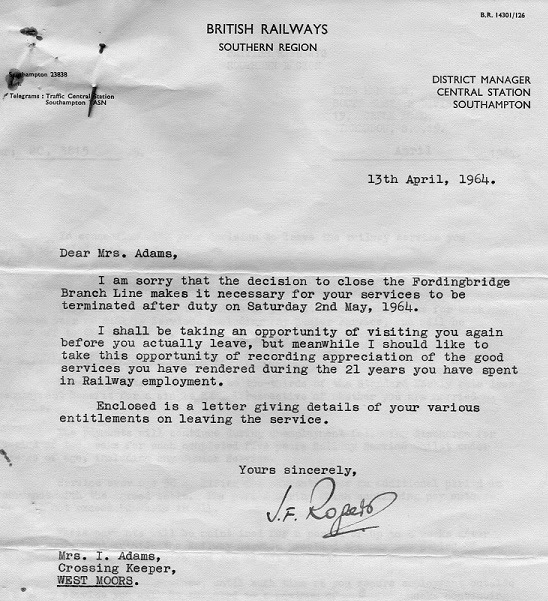
Ina died in 1992, in the Lodge she had occupied since the early 1940s. She, like thousands of others across the country since the mid-19th century, provided a valuable service to the community: this has largely gone unrecorded and unregarded. However I reproduce these thoughts from her son, Aubrey . . . ” Mum would have been horrified to know that her predicament was national; she just thought she was a one-off living in a backwater, but was happy with her lot. “
I have presented this text in the hope that some recognition is given to these stalwarts of the railway system: trains would hurtle past these often isolated crossing lodges – the passengers looking out and not comprehending that without the dedication of such as Ina Adams, their journeys would have been considerably less safe.
References:
“Many and Great Inconveniences”, by Philip A Brown: South Western Circle monograph No.2, published in 2003.
” Railwaywomen”, by Helena Wojtczak: The Hastings Press, published in 2005.
And other publications as referenced in the body of the article.
Also, in respect of Revel’s/Revells Crossing, additional information from the son of the last crossing-keeper, Aubrey Adams – who was born in the Lodge!
